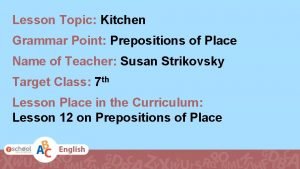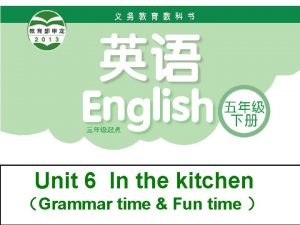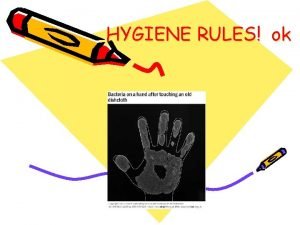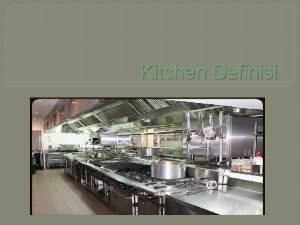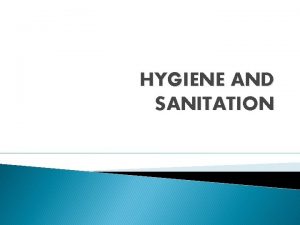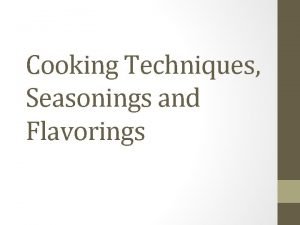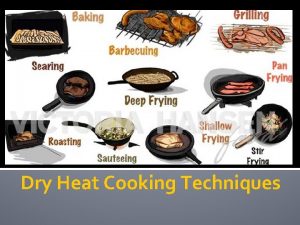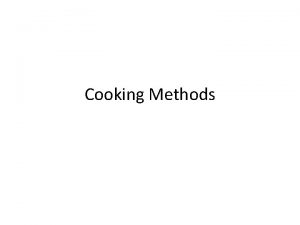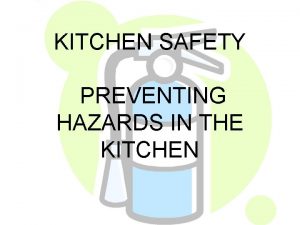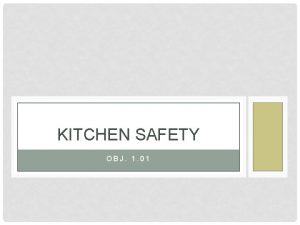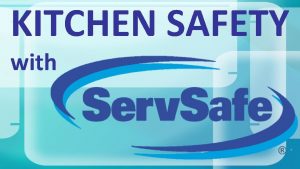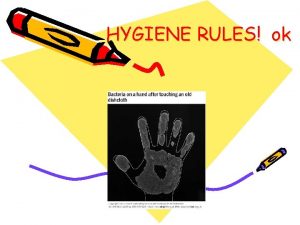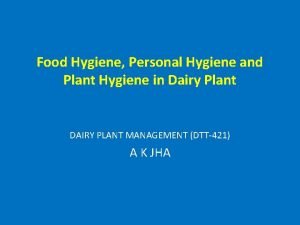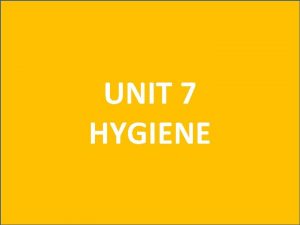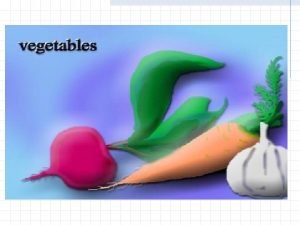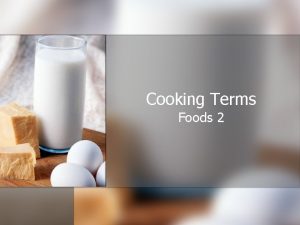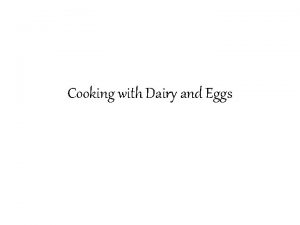Cooking Preparation Hygiene in the Kitchen Hygiene in


















- Slides: 18

Cooking Preparation

Hygiene in the Kitchen

Hygiene in the Kitchen � Tie back hair � Remove jewellery � Put on clean apron � Wash hands before handling food, after touching hair, face or sneezing � Make sure work area is clean

Safety in the kitchen � Never handle electric equipment with wet hands � Keep handles of saucepans turned in � Never walk around while holding knives or hot saucepans � Never run in the kitchen � Wipe up spills at once � Use oven gloves when removing hot tins from the oven

Unit Setup � Put all the books at the back of the room

Recipe �A recipe has: The name of the dish. Sometimes a picture of the finished dish. A list of ingredients. The method (instructions on how to make the dish). Serving suggestions. Oven temperature and cooking time. • • • � Before starting to cook, read the recipe well.

Weighing • • • Solids are weighed in grams (g). Since a gram is a very small amount, you will rarely see less than 25 g written in a recipe. If less than 25 g is needed, the recipe will usually say a teaspoon (5 g), dessertspoon (10 g) or a tablespoon (15 g). Recipes mean a level spoon unless otherwise stated. Note: 1, 000 g = 1 kg.

Weighing Scales

Measuring Jug

Measuring spoons • Liquids are measured in millilitres (ml). • There are 1, 000 ml in one litre (L). A measuring jug is used to measure liquid; again, less than 25 ml is rare in recipes. Teaspoons (5 ml), dessertspoons (10 ml) and tablespoons (15 ml) can also be used to measure liquids. • Measuring spoons, while not essential, can be used for small amounts, e. g. baking powder. level heaped Recipes mean a level teaspoon unless otherwise stated

Oven Management � Cookers can run on either electricity, gas or solid fuel. � A cooker can consist of: • A hob. • A grill (sometimes also a small top oven). • An oven. Preheating: Ovens can take 10 minutes to heat up (gas ovens heat up more quickly). You must preheat the oven for bread and cakes in particular. Setting the oven: Oven temperature is written in degrees Celsius (°C) or gas mark 1 to 9. Some older ovens may be in degrees Fahrenheit (°F). Each recipe will give an oven temperature and a cooking time.

� There are basically two different types of oven: • Conventional. • Fan (fan in oven at the back). � The temperature in a fan oven is the same on every shelf. In a conventional oven, the top shelf is hottest, the middle shelf is as you set it and the bottom shelf is coolest. Note: Arrange the shelves before you turn the oven on. Never place food on the floor of the oven, as it will burn. 205°C 200°C 195°C

Cleaning � Fill the skin with hot saopy water � Move everything to the right of the skin � Wipe down counter � Start with cleaniest item � Dry well � Place on counter to be checked by teacher

Put items away correctly � - Under sink 2 saucepans 2 pot stands 1 frying pan 1 colander 1 wire wrack Cutlery drawer 2 knives 2 forks 2 spoons 2 teaspoons measuring spoons pastry brush peeler masher rolling pin 2 wooden spoons Fish slice spatula Press chopping board measuring jug sieve 2 plates grater weighing scales mixing bowl

Cooking Food Reasons for cooking food � Heat kills harmful bacteria � Helps to preserve food longer � Makes food easier to digest � Cooking improves the appearance, colour and flavour

Heat causes changes in food � Protein coagulates and hardens food e. g. eggs and cheese � Some foods loose water and shrink e. g. meat, fish � Starch absorbs liquid and swells e. g. rice, pasta and thickened sauces � Some foods soften and break up e. g. potatoes and apples � Fats melt e. g butter � Colour changes e. g. meat and bread � Some nutrients are lost e. g. vit B and C and minerals

Over cooking causes � Greater loss of nutrients � Loss of colour, flavour and texture � Toughness and indigestibility e. g. meat and cheese � Waste of fuel

Heat travels in three ways Conduction Convection Radiation Heat passes from molecule to molecule e. g. shallow frying heat travels from hot pan into the food Heat travels in convection current through water/air/oil. These heat the food. Moist cookery methods are based on convection of water or steam which is heated at the heat source, rises then falls as it cools Heat travels to the food in straight rays. Grilling cooks by radiation the outside is heated by rays from the grill, and the heat then passes into the food by conduction
 Prepositions of place
Prepositions of place In the kitchen or at the kitchen grammar
In the kitchen or at the kitchen grammar Kitchen hygiene rules
Kitchen hygiene rules Apa arti kichen
Apa arti kichen Làm thế nào để 102-1=99
Làm thế nào để 102-1=99 Lời thề hippocrates
Lời thề hippocrates Glasgow thang điểm
Glasgow thang điểm đại từ thay thế
đại từ thay thế Vẽ hình chiếu đứng bằng cạnh của vật thể
Vẽ hình chiếu đứng bằng cạnh của vật thể Quá trình desamine hóa có thể tạo ra
Quá trình desamine hóa có thể tạo ra Thế nào là mạng điện lắp đặt kiểu nổi
Thế nào là mạng điện lắp đặt kiểu nổi Sự nuôi và dạy con của hổ
Sự nuôi và dạy con của hổ Các châu lục và đại dương trên thế giới
Các châu lục và đại dương trên thế giới Các loại đột biến cấu trúc nhiễm sắc thể
Các loại đột biến cấu trúc nhiễm sắc thể Biện pháp chống mỏi cơ
Biện pháp chống mỏi cơ Bổ thể
Bổ thể độ dài liên kết
độ dài liên kết Thiếu nhi thế giới liên hoan
Thiếu nhi thế giới liên hoan Tia chieu sa te
Tia chieu sa te
